
Understanding Google’s Local Search Algorithm and Local Ranking Factors
Published: May 5th, 2020
Last Updated: February 5th, 2025
Ranking in local search is becoming more difficult every day. Why? Competition. The Google local algorithm is constantly updating to ensure that search results best match the intent behind a user’s query.
As SEO specialists and digital marketers, staying informed about updates is essential to adapting our strategies effectively. Failing to do so can quickly diminish our local search presence. This advanced guide will help you understand the local search algorithm by breaking down the three major ranking pillars and explore specific ranking factors within these pillars that can significantly impact a business’s local search position. By the end, you’ll be equipped to stay ahead of the competition and know exactly what to focus on.
Google’s Local Search Algorithm
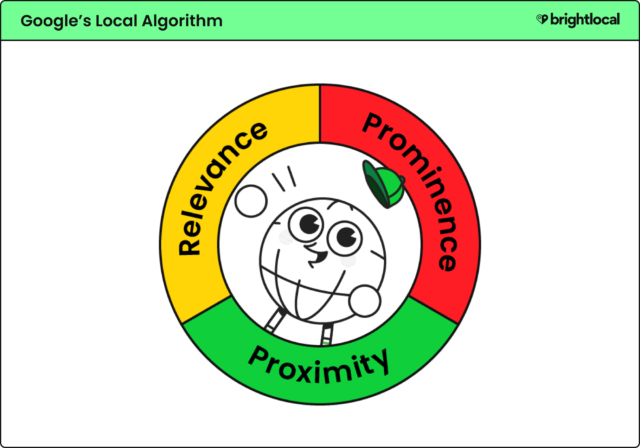
Google’s local search algorithm uses three key components to determine which businesses appear in local search results: proximity, relevance, and prominence.
Proximity
Proximity refers to the physical distance between the user’s search query and the business. The closer a business is to the user’s location (or the location they are searching for), the more likely it is to appear in the search results. This is one of the most crucial factors, especially for users performing searches with local intent.
There isn’t much a business can do to target this pillar. However, making sure that your Google Business Profile and other listings have an accurate Name, Address, and Phone Number (NAP) is a good start.
Relevance
Relevance measures how well a business listing matches the search query. Factors like business categories, keywords on the business website, and user-generated content (e.g., reviews) can help improve relevance. A business that aligns well with a search term is more likely to be ranked higher.
Local ranking factors that Google includes in this pillar include:
- Local listings and citations
- On-page signals, including content
- Google Business Prorfile
- Backlinks
- Personalization signals
Prominence
Prominence looks at how well-known and trusted a business is within its community or industry. This factor is influenced by external signals such as backlinks, social media mentions, online reviews, and how frequently a business is mentioned across the web. Prominent businesses that are often referenced and have a higher reputation tend to rank higher in local searches.
Local search ranking factors that Google includes in this pillar include:
- Reviews
- Google Business Profile and other listings
- Backlinks
- Behavioral signals
Together, these three factors form the backbone of Google’s local ranking system. However, within these categories, a number of specific ranking factors can significantly influence a business’s local search position. Let’s break down the individual ranking factors that come into play.
Local Search Ranking Factors for Local SEO
There are certain factors that determine how well a business performs within the realms of proximity, relevance, and prominence.
This table shows what experts in the 2023 survey identified as the top local search ranking factors, divided into Local Pack and localized organic categories.
| Local Pack | Local Organic |
|---|---|
| 1. Google Business Profile (32%) | 1. On-page (36%) |
| 2. On-page (19%) | 2. Links (26%) |
| 3. Reviews (16%) | 3. =Behavioral (9%) |
| 4. Links (11%) | 3. =GBP (9%) |
| 5. Behavioral (8%) | 4. =Personalization (7%) |
| 6. Citations (7%) | 4. =Citations (7%) |
| 7. Personalization (6%) | 5. Reviews (6%) |
To improve both Local Pack and localized organic rankings, you might find it useful to know the average importance of the local SEO ranking factors across both:
- On-page optimization (28%)
- GBP (21%)
- Links (19%)
- Reviews (11%)
- Behavioral signals (9%)
- Citations (7%)
- Personalization (7%)
Let’s run through each one and see how they influence proximity, relevance, and prominence.
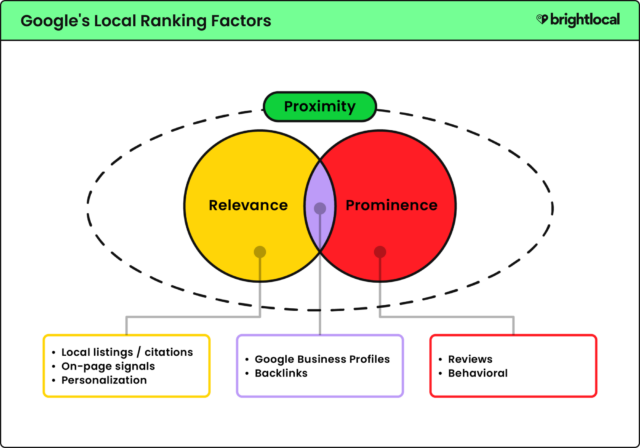
1. On-Page Signals
Optimizing your web pages for given keywords will increase relevance and enhance your chances of being favored by the Google local algorithm. According to Moz’s Local Ranking Factors report, website content relevance accounts for 15% of local search ranking factors, making it an essential component of any local SEO strategy.
Below is a list of on-page attributes that should be considered when trying to increase relevance for a given keyword or topic.
On-Page Checklist: Relevance
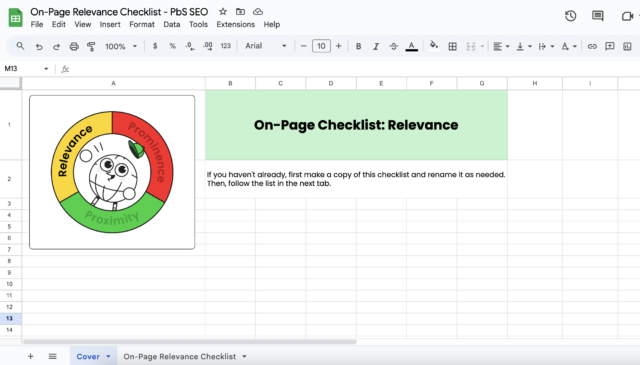
Stay organized: Use this on-page SEO checklist to keep track of your optimization efforts. Just ‘make a copy’.
Here are some of the on-page signals Google looks at:
Keywords
The key to ranking is ensuring your content is highly relevant to a user’s search query. Google’s 2018 core algorithm update emphasized content relevance over content length or quality. Since then they’ve doubled down on Expertize, Experience, Authority, and Trust (EEAT) signals and in 2022 launched the Helpful Content Update.
Simply put, if your content aligns with what users are searching for and it’s written with true authority, it’s more likely to rank higher.
The key to starting this, is keywords.
- LSI Keywords: By including keywords in your content that are semantically related to each other you increase relevance to your target keyword or query. Search engines are very smart; they are capable of drawing connections between keywords and rewarding pages that do so properly. Tip: Use Google’s search predictor or a tool like this to help.
- Long-tail Keywords: These keywords differ from LSI keywords but also add relevance. Although these keywords are longer, they do tend to convert higher. This is because they are usually more specific and descriptive. Long-tail keywords help add context to your content which helps search engines determine if your page matches the context of a user’s search query.
It all starts with good local keyword research.
Title Tag
First impressions count! Your title tag is one of the first things users see in search results. Make sure it incorporates your target keyword and clearly signals what the page is about. A well-crafted title tag not only helps with SEO but also encourages users to click.
Meta Description
Your meta description is an opportunity to expand on the title tag and provide more context. Including your target keyword here further boosts relevance and provides users with additional details about what to expect from the page.
Body Tags (H1, H2, etc.)
Headings help structure your content and improve relevance. Use descriptive body tags like H1, H2, etc., to break up your content. These tags are not only helpful for readers but also give search engines a better understanding of your content. Be sure to include relevant keywords, especially in your H1 tag, which is the most prominent heading on the page.
Internal and Outbound Linking
Effective linking strategies—both internal and outbound—are essential for boosting relevance and improving the user experience on your website.
- Internal Links: These help users navigate to relevant pages on your website. They help establish hierarchy and spread link equity throughout a website. You can use internal linking to increase relevance for a page by creating a navigation path to similar pages or pages that help strengthen your topic or keyword.
- Outbound Links: Outbound links direct users to external websites for additional information on related topics. These links not only enhance the user experience but also help the Google local algorithm understand your niche. Focus on providing high-quality, relevant outbound links to strengthen your site’s credibility and relevance in the eyes of search engines.
Inbound linking is a whole other kettle of fish, and we’ll get to that later.
Alt Text
Every user consumes information differently, and some people are very visual. As such it’s best to try to include images with your content wherever possible. These assets will help increase user engagement, which helps with ranking.
Whenever you add images to a page you have the option to add alt text, which is a way for search engines to easily crawl and understand what the media is. This is another great place to incorporate keywords. If you have an image that showcases a service your business offers, you want that alt text to include the service keyword. It’s also a really important aspect for accessible reasons, to ensure your content can reach as many people as possible.
Schema
Schema helps you organize and provide search engines like Google with the information they need to understand your content. It helps ensure the best search results possible and improves the way your page is displayed in search results. By adding schema to a page, you can increase the relevance for a given topic or keyword. Search engines can easily find schema and make sense of the content that it represents, helping to ensure that you show up when you should.
Read more: Local Schema Templates
URL Structure
Setting up your website’s hierarchy and site architecture is very important. It allows you to tell search engine algorithms how to prioritize and crawl your website. The URL slug that you use should reflect the topic of the page — this is another quick way to increase relevance.
Treat these on-page signals as a checklist. You should be able to go through your target page and check off every one of the above attributes. Once you get through this checklist, you should be able to confidently say that your page is relevant to your target keyword or topic, and so your site is more likely to be favored by the Google local algorithm.
Read more: On-page SEO for Local
2. Google Business Profile Signals
Whether you’re optimizing your Google Business Profile (GBP) (formerly Google My Business), Bing Places, or Yahoo Local, ensuring your listing is fully optimized is crucial—studies show that businesses with complete GBP profiles are 70% more likely to attract customer engagement. To achieve this, focus on maintaining accurate NAP (name, address, phone number) information, having a single claimed listing, and properly completing these two essential features.
Categories
Selecting the appropriate primary category for your business is crucial for local search rankings. According to Whitespark’s 2023 Local Search Ranking Factors survey, the primary category is the top factor influencing rankings in Google’s Local Pack. In addition to the primary category, selecting relevant additional categories can further enhance your visibility. However, it’s essential to ensure that all chosen categories precisely define your business to maintain relevance and effectiveness.
For a comprehensive list of categories, you can refer to this list of Google’s Business Profile categories. Similarly, Bing Places offers a detailed list of categories.
A 2023 GBP Category Study from BrightLocal found that businesses using four additional categories within their GBPs have the highest average map ranking of 5.9.
Description
By adding a description of your business, you allow users to know exactly what you do (as well as search engines). This shouldn’t be salesy, or an attempt to market your business. Instead, it should give users (and search engines) the info they require to determine if your business matches their needs or intent.
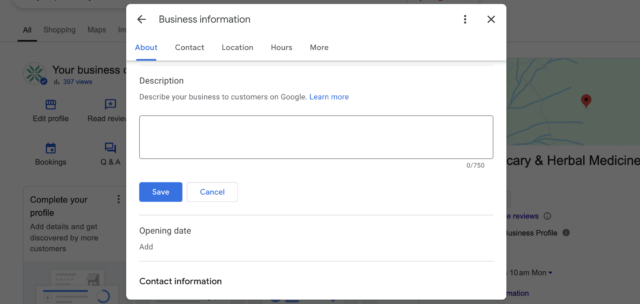
Google Business Profile Factors That Don’t Impact Rankings
You don’t need to take advantage of every aspect of GBP if you’re only focusing on improving your rankings.
The 2023 Local Search Ranking Factors survey experts are in agreement that several GBP-related factors don’t impact rankings.
These include:
- Geo-tagged photos uploaded to GBP
- Keywords in GBP description
- Keywords in GBP products
- Keywords in Google Posts
- Keywords in GBP services
- GBP messaging feature enabled
- Frequency of Google Posts
- Setting service areas
Remember, there’s more to Google Business Profile than just rankings. The actions that don’t influence rankings could still contribute to conversions, so it’s a good idea to pay attention to the bigger picture.
3. Link Signals
Backlinks are critical indicators of trust and credibility for search engines. High-quality backlinks from reputable and relevant websites boost your website’s authority, signaling to search engines that your content is reliable and valuable. This directly impacts both prominence and relevance.
A “good” backlink comes from a credible site with a strong Page or Domain Authority that aligns with your page’s topic. For instance, a service page about “car insurance” benefits from links on insurance-related or, better yet, car insurance-specific pages. These links not only increase the prominence of your site by associating it with authoritative sources, but they also improve relevance by reinforcing the specific topic of your content. Conversely, a link from a “home insurance” page would hold less value due to its lack of topical relevance, diminishing its effectiveness in boosting both prominence and relevance.
In local, relevance can trump things like domain authority. A number of links from other trusted sources in your local area, for instance, could do a lot to help your situation.
To learn more about local link building, check out these resources:
A word of caution: Bad backlinks can actually be harmful to your site overall, so it’s critical to assess the quality of the websites you’re getting links from. A simple way to do this is to download the MozBar Chrome extension.
The MozBar tool will show you the domain authority of the website you’re visiting, as well as the page authority of the individual page you’re on. The higher both of these numbers are, the better the quality of the site.
You can also use this tool to check the spam score of a website. If the spam score is high, then it’s probably best to avoid this website as a link could be detrimental to your SEO efforts.
4. Review Signals
Online reviews for a business not only have the power to increase ranking signals but the power to push a consumer to a decision. You can never have enough reviews!
Ask yourself, would you trust a business with 100 reviews or 10? Chances are it’s the former. That’s because (like the Google local algorithm) users need to gain trust from a brand before purchasing or clicking. So, similar to users, search engines have the ability to analyze the type of review, how many reviews a business has, and how they interact with reviews (respond to them or not). All these factors can increase a brand’s online prominence.
Additionally, the language used in reviews can impact your relevance by reinforcing important keywords or phrases associated with your business. For example, if customers frequently mention your services, products, or location, it helps search engines better understand what your business offers and where it operates.
Here are some tips to strengthen the impact of your online reviews.
Develop a Review Strategy
In order for a business to gain more reviews, you need to develop a strategy. This is very important. If you want to have a great online brand prominence, you need to first find a way to get more reviews. There are lots of tools available to help you generate more reviews.
Respond to Reviews
Once you have a strategy in place, you need to find a way to monitor and manage your reviews. This is just as important as getting reviews. Search engines are able to tell if you engage with customers and reply to their comments. It shows that you’re active and willing to interact.
Display relevant Reviews
Ensure that reviews on specific product or location pages are related to the page’s content. Reviews mentioning specific locations should be displayed on the relevant pages of your site.
A great tool to use is Brightlocal’s Reputation Manager tool. You can monitor all your reviews and highlight the ones you need to respond to. This is especially important for negative reviews. Yes, negative reviews aren’t great but you can respond to them in a positive, proactive way that can turn that negative review around.
Remember that you want to stand out from competitors, and you want your brand prominence to look good in the eyes of users and Google’s local algorithm.
To learn more about online reviews, check out these resources:
5. Behavioural Signals
Behavioral signals—such as click-through rate, mobile clicks to call, and dwell time—are user-driven actions that impact both prominence and relevance. While their importance has fluctuated, with Local Pack/Finder ranking influence at 8% in 2023, they remain a reliable indicator of user engagement.
Behavioral signals are a reliable source of information for Google because they’re much harder to manipulate than other factors. These actions are taken by the searcher and, therefore, can only be influenced to a certain degree.
Instead of thinking up innovative new ways to influence user behavior, why not spend this time optimizing your GBP to give the user the best possible experience? This involves creating optimized copy for titles, meta descriptions, Posts, and more. Make your listing as valuable and coherent as possible, and you’ll move closer to winning at rankings and conversions.
Try to remember that the end goal of SEO isn’t just to improve rankings, the focus must also be to attract the right customers to a business for those all-important sales. When you start getting seen by the right customers—those who want to learn more about your business—these users will naturally help to enhance the behavioral signals towards your site.
6. Local Citation and Listing Signals
Local citations—mentions of your business’s name, address, and phone number (NAP) across the web—are important for establishing local prominence. While they don’t require a backlink, the more citations your business has in reputable local directories like Yelp, Yellow Pages, and local chambers of commerce, the more authoritative it appears to Google.
Take a look at the example below of a recent Google search for ‘Cafe in Sacramento’. You can see that there are several results from business directories, including the top three spots!

When it comes to local SEO, consistency is key—especially when it comes to your business’s name, address, and phone number (NAP). Discrepancies in NAP data across directories and local listings can confuse Google, ultimately impacting your rankings. In fact, businesses with consistent NAP data across major citation sources are 40% more likely to appear in the local pack. That’s a significant boost to your visibility and credibility!
Building these citations can be incredibly time-consuming, so a service like BrightLocal’s Citation Builder can be a huge time and cost saver.
Therefore, it’s important to track your citations to ensure they are accurate and consistent. To get started, use tools like Brightlocal’s Citation Tracker to identify existing, incorrect, and potential citations. This will help you focus on the most valuable citations and ensure they’re correct and up-to-date.
To learn more about citations, check out these resources:
7. Personalization Signals
Personalization signals shape search results based on a user’s preferences, behavior, and search history, influencing proximity, prominence, and relevance. For proximity, search engines consider the user’s current location or habitual searches to deliver results nearby. Prominence is affected by interactions with businesses—like clicks or calls—which boost visibility for listings users trust or engage with frequently. Relevance is enhanced as search engines tailor results to align with user preferences, such as prioritizing vegan restaurants for someone who often searches for vegan options. By focusing on these factors, personalization ensures users find businesses most aligned with their needs and habits.
Although personalization can have an impact on general search results, it is much less likely to impact local search results. This means there’s not much you can do from an SEO perspective to optimize a website for personalization considerations.
Businesses that serve customers in countries with different native languages can translate—and therefore personalize—their content to reach the relevant audiences. Multilingual SEO is a largely underutilized resource that local businesses can tap into where appropriate.
It’s worth noting that in the US, 60 million people—almost a quarter of the population—aren’t native English speakers. So, if you operate a business in a multicultural city, then it’s likely worth targeting your website at the languages besides English that are commonly spoken.
To learn more about personalization in search, check out these resources:
The Evolution of Local Search Ranking Factors Over Time
Local search ranking factors have evolved significantly over the years. Previously, businesses could rely more heavily on keyword usage, backlinks, and directory listings to rank. However, Google has increasingly relied on machine learning and AI to understand user intent and deliver the most relevant local results.
- Mobile Search Growth: The rapid growth of mobile search has shifted priorities over time, with Google focusing heavily on ensuring businesses are optimized for mobile devices.
- User-Generated Content: The importance of user reviews, questions, and Q&A sections has grown exponentially. In recent years, businesses with a higher volume of positive, consistent reviews have seen a marked improvement in rankings.
- The Role of AI: With Google incorporating more AI and natural language processing into its algorithm, search results are becoming even more context-aware. Businesses that align with searcher intent through relevant, high-quality content now stand a better chance at ranking higher.
30% of mobile searches are related to a location. – Google, 2016
Local Pack / Local Finder Ranking Factors Over Time
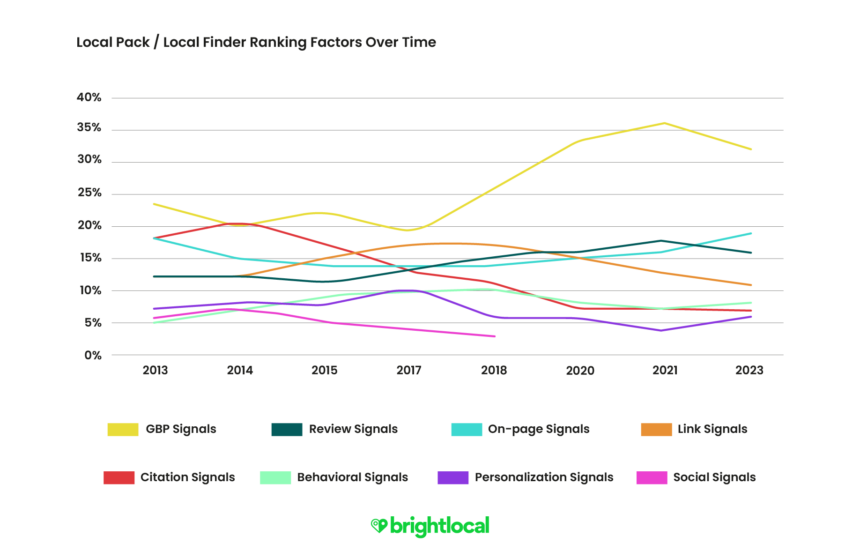
Local Organic Ranking Factors Over Time
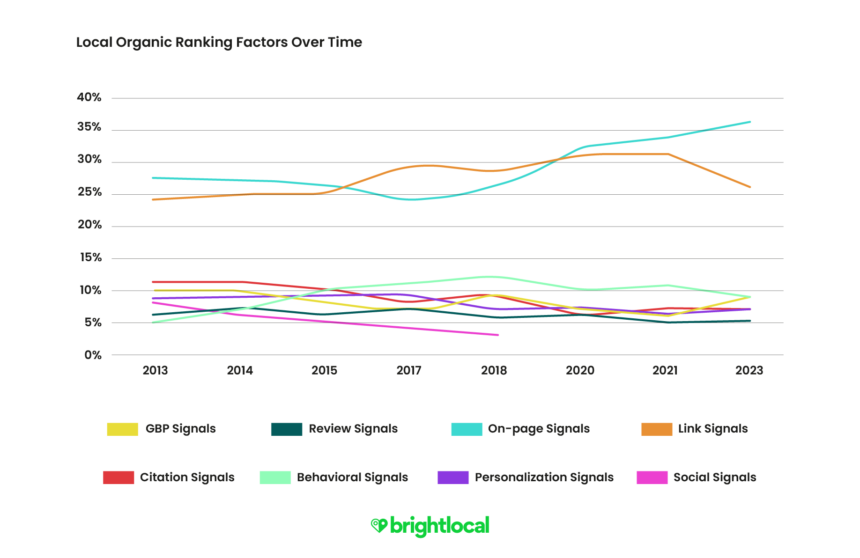
Where does this data come from? The Local Search Ranking Factors survey has been conducted near-annually since David Mihm kicked it off in 2008, with Whitespark taking over in 2017. The survey polls around 50 local SEO experts for their opinions on the most important actions and factors for local business rankings.
Conclusion: Actionable Insights for Improving Local Rankings
In conclusion, ranking in local search is becoming increasingly challenging as competition intensifies and Google’s algorithm continues to evolve. Staying informed about algorithm updates and understanding how they impact search rankings is crucial to success in local SEO. As we’ve discussed, incorporating relevant keywords, generating positive reviews, obtaining authoritative backlinks, and maintaining consistency in business information are all essential steps. By continuously refining your approach, you can enhance your local search presence, stay ahead of competitors, and ensure that your business stands out in an increasingly crowded online landscape.